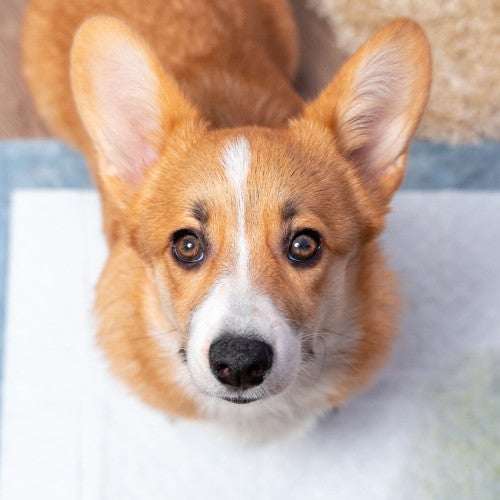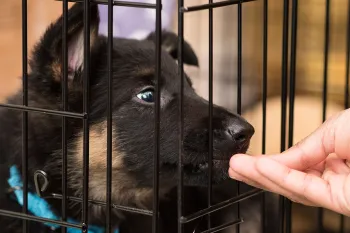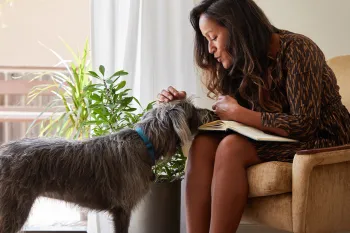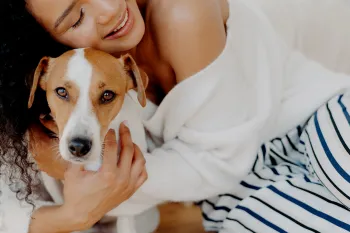Potty training your puppy is one of the first and most important lessons for a happy, clean home. These housebreaking tips will help you teach your puppy where and when to go while avoiding common mistakes along the way.
Establish a Potty Training Routine
Take your puppy outside frequently [at least every two hours] and especially after they wake up, after play sessions, and after eating or drinking.
Choose a consistent bathroom spot outside and always take your puppy there on a leash. While they’re relieving themselves, use a specific word or phrase (like “go potty”) so they learn to associate the command with the action. Once your puppy has finished, reward them immediately with praise or a treat to reinforce the behavior.
Pro Tip: Wait until your puppy is completely finished before offering praise or rewards. Puppies are easily distracted and may stop midway if interrupted.
Meredith Lee /Humane World for Animals
Gifts that can change lives
Help animals in need this holiday season. You can be the hero they need with a lifesaving gift. Please, give now if you can.
Stick to a Feeding Schedule
Keeping your puppy on a consistent feeding schedule makes housebreaking much easier. Puppies usually need to relieve themselves soon after eating, so feeding them at the same times each day encourages predictable potty times.
Additionally, remove your puppy’s water dish about two and a half hours before bedtime to reduce overnight accidents. Most puppies can comfortably sleep for seven hours without a bathroom break. If your puppy wakes you up, stay calm, take them out quietly, and return them to bed without turning it into playtime.
Supervise Closely Indoors
Until your puppy is reliably potty trained, supervise them closely while indoors. Tether them to you or a nearby piece of furniture with a 6-foot leash when not actively playing or training.
- Watch for signs that they need to go out:
- Barking or scratching at the door
- Circling or sniffing the floor
- Restlessness or sudden squatting
When you notice these signals, immediately take your puppy to their designated potty spot. If they eliminate, reward them right away.
Keep your puppy on a leash in the yard during the housebreaking process, treating the yard like any other room in the house.
Use Confinement When You Can’t Supervise
If you’re unable to watch your puppy, restrict them to a small area where they won’t want to eliminate — like a section of the bathroom or laundry room blocked with baby gates.
Another option is crate training, a reliable and humane method for confinement. If your puppy has been confined for several hours, take them straight to their potty spot as soon as you return.
How to Handle Potty Training Accidents
Accidents will happen — it’s a normal part of training. Here’s how to handle them:
- Calmly take your puppy to their outdoor potty spot.
- Praise and reward if they finish there.
- Never punish your puppy for accidents. Scolding or rubbing their nose in it will only make them fearful and slow progress.
Clean soiled areas thoroughly to remove scents that might encourage repeat accidents.
Plan for When You’re Away
If you’ll be away from home for more than four or five hours a day, consider whether this is the right time for a puppy. An alternative might be adopting an older, house-trained dog.
If you must leave your puppy alone:
Arrange for a neighbor or pet sitter to take them for bathroom breaks.
Or, train them to use indoor potty options like pee pads, newspapers, or a sod box. Keep in mind that indoor potty training can make outdoor housebreaking take longer.
When cleaning up accidents outside the designated potty area, place the soiled paper towels or rags in the appropriate spot to help your puppy associate the scent with the correct bathroom location.
Final Thoughts
Patience, consistency, and positive reinforcement are the foundations of successful potty training. By sticking to a regular schedule, supervising your puppy, and managing accidents correctly, you’ll set your new companion up for success in your home.
Frequently Asked Questions
Housetraining a puppy typically takes 4-6 months, but it can vary depending on the puppy's size, age and previous housetraining habits. Consistency is key, so establish a regular potty schedule and reward successful trips outside. Crate training can also be a helpful tool in the housetraining process.
Puppies need to pee frequently. In general, a puppy may be able to hold their bladder for about one hour for every month of age. So, a 3-month-old puppy may need to pee every 3 hours, and it's important to take them out regularly to avoid accidents. Create a potty schedule for the first 6-9 months to help your puppy learn consistency.
There are several signs that indicate a dog needs to pee, including restlessness, circling, sniffing excessively and heading towards the door. They may also start squatting or lifting their leg if they are already in the process of going. Paying attention to these cues and acting quickly can help prevent accidents. Never punish your puppy for having an accident. Instead, prevent accidents by creating a schedule so they learn consistency.
Every dog is an individual. Smaller dogs and those who weren't allowed outside as puppies (ex. those rescued from puppy mills), may need more potty breaks than larger dogs and those who were given consistent opportunities to go outside as a puppy. Regular potty breaks are essential for maintaining good hygiene and preventing accidents indoors. If your dog has an accident, try shortening the time between breaks.
Accidents are a normal part of potty training a puppy, especially in the early stages. Expect frequent accidents initially, but as the puppy learns a consistent routine, the number should gradually decrease. Focus on positive reinforcement and consistency to minimize accidents and encourage good habits. If your puppy is really struggling, reach out to a veterinarian or positive-reinforcement based dog trainer for support.
To train your dog to signal when they need to potty, start by associating a specific action, like ringing a bell or barking at the door, with going outside. Reward them immediately after they perform the action and then successfully potty outside. With consistent repetition, your dog will learn to use the signal to communicate their need to go.



